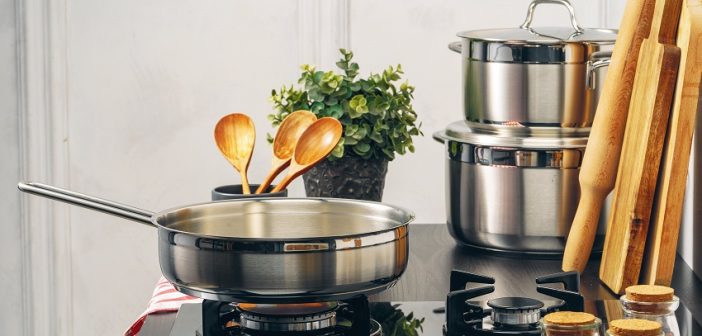Stainless steel is perhaps the most used material for kitchen items, from utensils, pots, and pans to cooking gadgets. That irresistible shine will look great for years to come, and some are even passed from generation to generation. If you’re still unsure if you should cook with stainless steel cookware, hang on tight, we will soon untangle this step by step.
The Benefits of Cooking with Stainless Steel Cookware
Chances are you already have a small stainless steel pot lying around in your kitchen and for a good reason. This short guide will go through each of its advantages so you can decide if you should invest in a stainless steel material full range or switch to another type of cookware.
Durability
Things are pretty clear in this department; stainless steel is practically indestructible.
- no chip
- no rust
- no bend
- no warp
- no unpleasant stains
If you cook daily, this right here is a great incentive, the wear and tear won’t leave any marks (at least not easily).
Safe Non-Toxic
High-quality stainless steel cookware is somewhat pricier than other mid-range options, but after a few uses, you will be convinced you made the right choice.
Even-Heat Conductivity
Stainless steel is known for its poor distribution. This is where a copper or aluminum-based core is gold! I know it is kind of confusing, but this way, your food will be cooked on an aluminum base while its core will increase its heat transferability.
Non-Reactive
Unlike aluminum, cast iron, and unlined copper, all reactive metals, stainless steel is non-reactive. You can cook tomato sauces or any acidic foods without having to worry about metal leaching or ending up having that unpleasant metallic taste.
Layered with other metals
As I’ve detailed earlier on, you might find stainless steel bonded with copper or aluminum.
Copper transforms into a great heat conductor as it reacts quite fast to temperature changes, resulting in an evenly heated cooking surface.
An aluminum core is sandwiched between two layers of stainless steelworks in the same way but is somewhat less efficient than copper. This is why stainless steel cookware with an aluminum core isn’t as expensive as cookware with a copper core.
Easy to Maintain
Stainless steel is an iron-based alloy that usually contains iron, chrome, and nickel. Having a non-porous surface translates to being incredibly easy to clean and maintain without having to season.
Small note here: you need at least a thin layer of cooking oil to prevent food sticking to the bottom of the pan. If this is your first time cooking in a stainless steel pan, you might have trouble estimating just how much oil you need.
Appearance
That shiny, mirror-like finish makes it the perfect choice if you keep your pots and pans on display. The timeless, elegant look will look good in any kitchen, regardless of the color scheme or the design aesthetic.
Alternative to Stainless Steel Cookware
Non-Stick Cookware
Advantages:
- affordable, making perfect as an impulse buy
- low maintenance, no seasoning required, easy to clean
- dishwasher-safe (make sure the manufacturer has instructions regarding this)
- non-reactive
- a great choice if you follow a low-fat diet as you can easily cook without using oils
- an excellent option for the inexperienced cook
- good heat distribution
Disadvantages:
- scratches easily so you have to use friendly utensils
- not all of them are safe to be used in the oven
Ceramic cookware
Advantages:
- non-stick
- lightweight thus easy to maneuver, which is extremely important, especially in a smaller kitchen
- non-reactive so no worries about metals leaching into the food you’re cooking
- easy to clean, in some cases a gentle washing by hand is all it takes
- available in a multitude of colors and color combinations
- safe and non-toxic
- budget-friendly option
Disadvantages:
- Durability is not their strongest selling point, even if you go for high-end cookware
- recommended to be used in low to medium heat only, otherwise, you will damage the ceramic coat
- metallic utensils will easily scratch the ceramic topcoat
- can be washed in the dishwasher but in time this will affect the ceramic coat
Carbon steel
Advantages:
- great for almost anything, from browning, braising, sauteing, stir-frying to searing
- can be used on gas, electric or induction cooker
- works on gas, electric and induction cooktops
- can be used on induction cooktops as well as gas and electric ovens
- It is quite versatile, working great for searing, browning, braising, sautéing, stir-frying, and even baking
- very durable, it can last for 10+ years
- minimalism classic and straightforward design
Disadvantages:
- if you skip seasoning it, you might see that acidic foods will cause the metal to leach into the dish, altering its taste and color
- quite expensive
- not dishwasher safe
Cast iron Cookware
Advantages:
- mid-range cookware will last a lifetime
- once you get it hot, it will stay hot for a while
- much more affordable compared to other handcrafted cookware
Disadvantages:
- very heavy, so you need to be super careful when working with them full
- reactive, so not a great option if you’re cooking acidic foods
- somewhat high maintenance to prevent rust
- / + during the cooking process some iron may transfer into the dish
Copper Cookware
Advantages:
- excellent thermal conductivity
- lightweight, making it easy to move around
- Cool looking, the type of cookware that will always get lots of praise
Disadvantages:
- you have to wash it and dry it with a towel afterward manually
- requires a lot of upkeep, so it doesn’t lose its shine
Bottom line
Did you make your mind up? Did you decide to cook with stainless steel cookware? Each type of cookware has its pros and cons, so it all boils down (pun intended) to your personal needs and budget.
If you’ll cook on an almost daily basis for a larger household, then it’s evident that you need something that will pass the test of time, and stainless steel fits the bill.
If instead, you only cook from time to time, and you just want a cookware set that is easy to clean and won’t cost you an arm and a leg, then ceramic cookware is a good contender.




